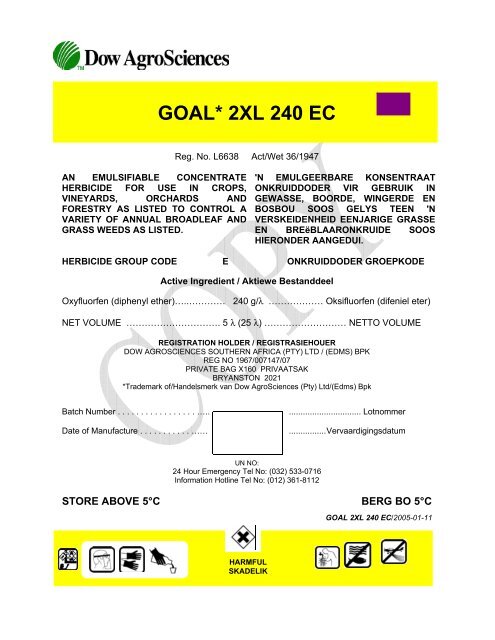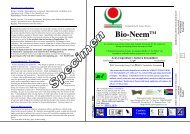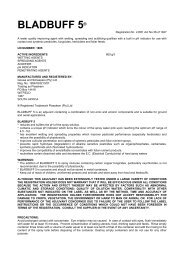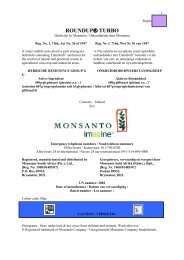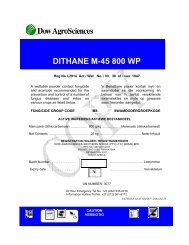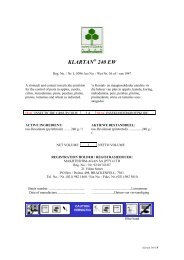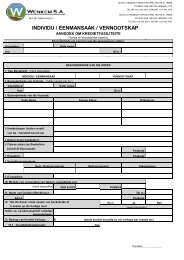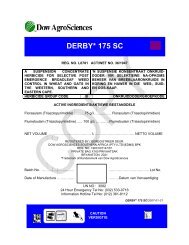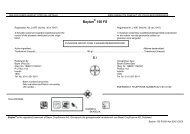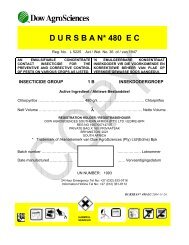GOAL* 2XL 240 EC - Wenkem
GOAL* 2XL 240 EC - Wenkem
GOAL* 2XL 240 EC - Wenkem
You also want an ePaper? Increase the reach of your titles
YUMPU automatically turns print PDFs into web optimized ePapers that Google loves.
<strong>GOAL*</strong> <strong>2XL</strong> <strong>240</strong> <strong>EC</strong><br />
Reg. No. L6638 Act/Wet 36/1947<br />
AN EMULSIFIABLE CONCENTRATE<br />
HERBICIDE FOR USE IN CROPS,<br />
VINEYARDS, ORCHARDS AND<br />
FORESTRY AS LISTED TO CONTROL A<br />
VARIETY OF ANNUAL BROADLEAF AND<br />
GRASS WEEDS AS LISTED.<br />
'N EMULGEERBARE KONSENTRAAT<br />
ONKRUIDDODER VIR GEBRUIK IN<br />
GEWASSE, BOORDE, WINGERDE EN<br />
BOSBOU SOOS GELYS TEEN 'N<br />
VERSKEIDENHEID EENJARIGE GRASSE<br />
EN BREëBLAARONKRUIDE SOOS<br />
HIERONDER AANGEDUI.<br />
HERBICIDE GROUP CODE E ONKRUIDDODER GROEPKODE<br />
Active Ingredient / Aktiewe Bestanddeel<br />
Oxyfluorfen (diphenyl ether)…..………… <strong>240</strong> g/λ ……………… Oksifluorfen (difeniel eter)<br />
NET VOLUME …………………………. 5 λ (25 λ) ……………………… NETTO VOLUME<br />
REGISTRATION HOLDER / REGISTRASIEHOUER<br />
DOW AGROSCIENCES SOUTHERN AFRICA (PTY) LTD / (EDMS) BPK<br />
REG NO 1967/007147/07<br />
PRIVATE BAG X160 PRIVAATSAK<br />
BRYANSTON 2021<br />
*Trademark of/Handelsmerk van Dow AgroSciences (Pty) Ltd/(Edms) Bpk<br />
Batch Number . . . . . . . . . . . . . . . . . ….. ............................... Lotnommer<br />
Date of Manufacture . . . . . . . . . . . …… ................Vervaardigingsdatum<br />
UN NO:<br />
24 Hour Emergency Tel No: (032) 533-0716<br />
Information Hotline Tel No: (012) 361-8112<br />
STORE ABOVE 5°C BERG BO 5°C<br />
HARMFUL<br />
SKADELIK<br />
GOAL <strong>2XL</strong> <strong>240</strong> <strong>EC</strong>/2005-01-11
WARNINGS:<br />
GOAL <strong>2XL</strong> <strong>240</strong> <strong>EC</strong> may be harmful if swallowed and may cause eye and skin irritation.<br />
Keep out of reach of children, uninformed persons and animals.<br />
Store in a cool place away from feed and foodstuffs.<br />
STORE ABOVE 5 °C.<br />
FLAMMABLE — keep away from heat and flame.<br />
GOAL <strong>2XL</strong> <strong>240</strong> <strong>EC</strong> is toxic to fish and other aquatic organisms.<br />
Avoid contamination of lakes, dams and rivers.<br />
RE-ENTRY INTERVAL: Do not enter treated area within 1 day after application unless<br />
wearing protective clothing.<br />
In case of poisoning, call a doctor and show him/her this label.<br />
Although this remedy has been extensively tested under a large variety of<br />
conditions, the registration holder does not warrant that it will be efficacious under<br />
all conditions because the action and effect thereof may be affected by factors such<br />
as abnormal soil, climatic and storage conditions, quality of dilution water,<br />
compatibility with other substances not indicated on the label and the occurrence of<br />
resistance of the weed to the remedy concerned, as well as by the method, time and<br />
accuracy of application. The registration holder furthermore does not accept<br />
responsibility for damage to crops, vegetation, the environment or harm to man or<br />
animal or for the lack of performance of the remedy concerned due to failure of the<br />
user to follow the label instructions or to the occurrence of conditions which could<br />
not have been foreseen in terms of the registration. Consult the supplier in the event<br />
of any uncertainty.<br />
PR<strong>EC</strong>AUTIONS<br />
Wear rubber gloves and face shield protection when handling the concentrate.<br />
Avoid contact with skin and eyes and do not breath in spray mist or fumes.<br />
Wash hands thoroughly with soap and water after use and before smoking, eating or<br />
drinking.<br />
Wash contaminated clothing daily.<br />
Avoid drift of spray mist onto other crops or areas not under treatment.<br />
Avoid contamination of water sources during cleaning of equipment and disposal of wastes.<br />
All spray equipment should be rinsed and sprayed through thoroughly with clean water<br />
immediately after use.<br />
Rinse the container three times with a volume of water equal to a minimum of 10 % of that<br />
of the container. Add the rinsings to the contents of the spray tank before destroying the<br />
container in the prescribed manner.<br />
Destroy empty container by perforating and flattening and do not use for any other purpose.<br />
Avoid contamination of foodstuff, feed, eating utensils and drinking water.<br />
2<br />
GOAL <strong>2XL</strong> <strong>240</strong> <strong>EC</strong>/2005-01-11
SYMPTOMS OF HUMAN POISONING:<br />
No case of human poisoning known.<br />
No clinical symptoms shown by test animals during chronic feeding studies.<br />
GOAL <strong>2XL</strong> <strong>240</strong> <strong>EC</strong> causes moderate skin and severe eye irritation.<br />
See MSDS for effects of components of formulations.<br />
FIRST AID TREATMENT:<br />
Inhalation: Move subject to fresh air. Apply artificial respiration and oxygen if needed.<br />
Eye and skin contact: Flush eyes with large quantities of water for 15 minutes. Consult a<br />
physician if irritation persists. Wash affected skin areas with soap and water.<br />
Ingestion: Do not induce vomiting. Wash out mouth with water and give water to drink.<br />
Contact physician immediately.<br />
NOTE TO PHYSICIAN:<br />
No specific antidote is recommended. Careful gastric lavage and general decontamination<br />
should be sufficient. If very large quantities of GOAL <strong>2XL</strong> <strong>240</strong> <strong>EC</strong> have been ingested<br />
treatment should be symptomatic if any symptoms do develop.<br />
USE RESTRICTIONS:<br />
Do not apply GOAL <strong>2XL</strong> <strong>240</strong> <strong>EC</strong> at all in nurseries, nor onto or over or in the vicinity<br />
of nursery plant material. The only exception to the use of GOAL <strong>2XL</strong> <strong>240</strong> <strong>EC</strong> on nursery<br />
plant material is for FORESTRY and only if usage is strictly according to directions on this<br />
label.<br />
RESISTANCE MANAGEMENT:<br />
For resistance management, GOAL <strong>2XL</strong> <strong>240</strong> <strong>EC</strong> is a Group code E herbicide. Any weed<br />
population may contain individuals naturally resistant to GOAL <strong>2XL</strong> <strong>240</strong> <strong>EC</strong> and other<br />
Group Code E herbicides. The resistant individuals can eventually dominate the weed<br />
population if these herbicides are used repeatedly. These resistant weeds may not be<br />
controlled by GOAL <strong>2XL</strong> <strong>240</strong> <strong>EC</strong> or any other Group Code E herbicides.<br />
To delay herbicide resistance:<br />
Avoid exclusive repeated use of herbicides from the same herbicide Group Code. Alternate<br />
or tank mix with products from different herbicide Group Codes.<br />
Integrate other control methods (chemical, cultural, biological) into weed control<br />
programmes.<br />
For specific information on resistance management contact the registration holder of this<br />
product.<br />
3<br />
GOAL <strong>2XL</strong> <strong>240</strong> <strong>EC</strong>/2005-01-11
DIR<strong>EC</strong>TIONS FOR USE: USE ONLY AS DIR<strong>EC</strong>TED<br />
GENERAL<br />
Mode of Action of GOAL <strong>2XL</strong> <strong>240</strong> <strong>EC</strong>:<br />
The active ingredient (Oxyfluorfen) possesses extremely low water solubility. After<br />
application it binds rapidly and tightly to clay particles and organic matter in the soil. The<br />
active ingredient thus does not leach in the soil and is not absorbed by roots. After<br />
application GOAL <strong>2XL</strong> <strong>240</strong> <strong>EC</strong> forms a thin layer or barrier on the soil surface when<br />
activated by moisture. Here it kills weeds through contact activity on shoots of germinating<br />
seeds or young seedlings as they seek to emerge. After application of GOAL <strong>2XL</strong> <strong>240</strong> <strong>EC</strong><br />
the soil surface must not be cultivated or disturbed for the expected period of weed control<br />
as disturbing the herbicide layer on the soil surface will adversely affect weed control.<br />
GOAL <strong>2XL</strong> <strong>240</strong> <strong>EC</strong> becomes activated by soil moisture. Application to damp, stabilized<br />
soil and a minimum of 5 mm rain or irrigation within 7 days after application is essential for<br />
effective weed control. Optimum residual effect is obtained if soil is not allowed to dry out<br />
completely at any stage.<br />
Application Requirements and Timing of Application:<br />
GOAL <strong>2XL</strong> <strong>240</strong> <strong>EC</strong> should be applied by tractor-mounted boom sprayer or knapsack<br />
sprayer equipped with Teejet flat fan-nozzles which should deliver the indicated volume of<br />
spray mixture per hectare at a pressure of 100 – 200 kPa. Ensure that the spray apparatus<br />
is correctly calibrated and that only clean water is used. The spray mixture must be<br />
continuously well agitated.<br />
GOAL <strong>2XL</strong> <strong>240</strong> <strong>EC</strong> has both post-emergence and residual action on both broadleaf and<br />
grass weeds. Post-emergence action is, however, limited to seedlings. For optimum<br />
residual effect GOAL <strong>2XL</strong> <strong>240</strong> <strong>EC</strong> should be applied prior to the emergence of weeds.<br />
GOAL <strong>2XL</strong> <strong>240</strong> <strong>EC</strong> should preferably not be applied to unstabilised soil (dry, dusty, freshly<br />
cultivated soil). It is preferable that the application should have been preceded by a light<br />
irrigation or rain. GOAL <strong>2XL</strong> <strong>240</strong> <strong>EC</strong> should not be applied to an organic mulch of more<br />
than 30 % coverage as results will be adversely affected. Remove excessive coverage of<br />
dead plant material (organic material) from the surface to be sprayed. GOAL <strong>2XL</strong> <strong>240</strong> <strong>EC</strong><br />
should not be applied to crops where drip irrigation is practiced as poor or variable weed<br />
control may occur because of inadequate moisture at the soil surface to activate the GOAL<br />
<strong>2XL</strong> <strong>240</strong> <strong>EC</strong> in areas outside the immediate area of the dripper.<br />
Crop Safety<br />
• It is important to note that the application of GOAL <strong>2XL</strong> <strong>240</strong> <strong>EC</strong> differs entirely from<br />
crop to crop and the specific directions for each crop should be adhered to closely.<br />
GOAL <strong>2XL</strong> <strong>240</strong> <strong>EC</strong> is held at the soil surface with the result that it can be splashed<br />
by rain or irrigation onto leaves of crops close to the ground. Because of its highly<br />
active contact action this may result in leaf scorching that will normally disappear<br />
with time.<br />
4<br />
GOAL <strong>2XL</strong> <strong>240</strong> <strong>EC</strong>/2005-01-11
Because of the highly active contact action of GOAL <strong>2XL</strong> <strong>240</strong> <strong>EC</strong> small spray<br />
droplets that may drift up into fruit trees and vines may cause leaf burn of immature<br />
leaves as well as small burn spots on young fruitlets. Scar tissue then develops<br />
around the burn spots that makes the mature fruit unacceptable for export. For this<br />
reason GOAL <strong>2XL</strong> <strong>240</strong> <strong>EC</strong> must be applied well prior to bud burst (4 weeks).<br />
Although GOAL <strong>2XL</strong> <strong>240</strong> <strong>EC</strong> may co-distill from moist soil and the vapour may then<br />
be absorbed by crop leaves, it is unlikely that this will cause serious crop injury.<br />
The usage of GOAL <strong>2XL</strong> <strong>240</strong> <strong>EC</strong> on Onions and similar crops:<br />
• Refer to recommendation tables for directions for use with the different planting<br />
techniques and crop stages.<br />
• Slight scorching or pigtailing of leaves may occur shortly after application of GOAL<br />
<strong>2XL</strong> <strong>240</strong> <strong>EC</strong> but this is normally of a temporary nature and full recovery takes place<br />
within a few weeks.<br />
• GOAL <strong>2XL</strong> <strong>240</strong> <strong>EC</strong> should only be applied to plants that have reached the 2 – 3 true<br />
leaf growth stage. Weak plants may be adversely affected by GOAL <strong>2XL</strong> <strong>240</strong> <strong>EC</strong>.<br />
• Unless specifically stated otherwise, all applications of GOAL <strong>2XL</strong> <strong>240</strong> <strong>EC</strong> on<br />
transplanted onions should be applied on damp, stabilized soil and should be<br />
followed immediately by a thorough irrigation.<br />
The usage of GOAL <strong>2XL</strong> <strong>240</strong> <strong>EC</strong> on brassica crops.<br />
• GOAL <strong>2XL</strong> <strong>240</strong> <strong>EC</strong> should be used as a pre-plant overall treatment for fields into<br />
which brassica crops are to be transplanted.<br />
• The soil surface to be treated should be well prepared with no large soil clods. A<br />
light irrigation of the prepared soil is recommended prior to application of GOAL <strong>2XL</strong><br />
<strong>240</strong> <strong>EC</strong>.<br />
• Transplant brassica crops into the treated soil only 7 – 10 days after application.<br />
Soil disturbance must be kept to the minimum.<br />
• Irrigate immediately after transplanting to prevent excessive wilting. A slight degree<br />
of leaf scorch may occur. This scorch is of a temporary nature and plants normally<br />
recover fully within a short period and new growth is not affected.<br />
• Do not apply GOAL <strong>2XL</strong> <strong>240</strong> <strong>EC</strong> after transplanting. Direct contact of GOAL<br />
<strong>2XL</strong> <strong>240</strong> <strong>EC</strong> with these crops will lead to severe damage.<br />
• GOAL <strong>2XL</strong> <strong>240</strong> <strong>EC</strong> is not recommended where a machine is used to do<br />
transplanting. This normally leads to excessive soil disturbance and breaks up the<br />
herbicidal layer, with resultant poor weed control.<br />
• Under cold, wet, windless conditions GOAL <strong>2XL</strong> <strong>240</strong> <strong>EC</strong> may cause serious damage<br />
to brassica crops that may lead to yield reduction. Late or unseasonal plantings of<br />
broccoli (after the beginning of August) should not be treated with GOAL <strong>2XL</strong> <strong>240</strong><br />
<strong>EC</strong>.<br />
• GOAL <strong>2XL</strong> <strong>240</strong> <strong>EC</strong> is recommended on the following cultivars:<br />
Cauliflower: Snowking, Snowcrown, Snow February, Snowcap, Couchamp, Igloo.<br />
Cabbage: Gloria Osena, NS Cross, Hercules, Bonanza, Drum Head, Green<br />
Coronette, Cape Spitz, Glory of Enkhuizen, Rolan, Shamrock, Rodelle.<br />
5<br />
GOAL <strong>2XL</strong> <strong>240</strong> <strong>EC</strong>/2005-01-11
Brussel Sprouts: Long Island, Jade Cross<br />
Broccoli: Green Sprouting Calabrese, Late Corona.<br />
Crop Safety regarding perennial crops such as fruit trees and vines:<br />
GOAL <strong>2XL</strong> <strong>240</strong> <strong>EC</strong> may be used on fruit trees and vines of all ages, provided the following<br />
guidelines are adhered to:<br />
• Do not apply GOAL <strong>2XL</strong> <strong>240</strong> <strong>EC</strong> at all in nurseries, nor onto or over or in the vicinity<br />
of nursery plant material.<br />
• Limit the use of GOAL <strong>2XL</strong> <strong>240</strong> <strong>EC</strong> to crops listed on the label.<br />
Only apply by directed application and avoid leaf contact with GOAL <strong>2XL</strong> <strong>240</strong> <strong>EC</strong> for<br />
all crops in this group.<br />
• Deciduous fruit and vines: Apply at least 4 weeks before budding. If rain does not<br />
fall within 7 – 10 days after application follow-up with a light irrigation of at least 5<br />
mm. Do not apply a GOAL <strong>2XL</strong> <strong>240</strong> <strong>EC</strong> rate of greater than 1 ℓ / ha to deciduous<br />
fruit or vines after budding has occurred and only after the beginning of December.<br />
• Citrus: Do not apply GOAL <strong>2XL</strong> <strong>240</strong> <strong>EC</strong> during the period of 3 weeks before<br />
blossoming till 3 weeks after fruitset.<br />
• Do not use where drip irrigation is practiced. Drip irrigation does not activate the<br />
GOAL <strong>2XL</strong> <strong>240</strong> <strong>EC</strong> at the soil surface. Sub-surface moisture may promote weed<br />
germination but a lack of surface moisture may lead to poor weed control.<br />
Unless specifically recommended on this label, GOAL <strong>2XL</strong> <strong>240</strong> <strong>EC</strong> must in no case be<br />
used in conjunction with any other weed killing compound in a specific season as injury to<br />
the crop may result. Before planting any follow up crops on soil previously treated with<br />
GOAL <strong>2XL</strong> <strong>240</strong> <strong>EC</strong> thorough and deep ploughing is recommended. A period of two<br />
months for each litre of GOAL <strong>2XL</strong> <strong>240</strong> <strong>EC</strong> previously applied per hectare, should be<br />
allowed to elapse before planting follow up annual crops. Direct seeded crops sown on soil<br />
that has been treated with GOAL <strong>2XL</strong> <strong>240</strong> <strong>EC</strong> within the preceding months must not be<br />
treated with acetamide herbicides. Crops not listed on this label that are planted nearby or<br />
between trees or vines, may be injured by GOAL <strong>2XL</strong> <strong>240</strong> <strong>EC</strong>.<br />
6<br />
GOAL <strong>2XL</strong> <strong>240</strong> <strong>EC</strong>/2005-01-11
CROP<br />
A. ANNUAL CROPS<br />
1. ONIONS<br />
1.1 Transplanted<br />
onions<br />
1.1.1 Long Season<br />
Cultivars<br />
1.1.2. Short Season<br />
cultivars<br />
RATES / ha<br />
3 litres<br />
OR<br />
1,5 litres<br />
+<br />
1,5 litres<br />
1,0 litre<br />
+<br />
1,0 litre<br />
OR<br />
1,5 litres<br />
+<br />
1,5 litres<br />
7<br />
REMARKS<br />
See notes under “DIR<strong>EC</strong>TIONS FOR USE”<br />
above.<br />
Application must be done directly after<br />
transplanting. Apply in 300 – 400 ℓ water<br />
per ha.<br />
Apply first application of 1,5 ℓ / ha<br />
immediately after transplanting and follow-up<br />
with a further application at the same rate<br />
after one month in 300 – 400 ℓ water / ha.<br />
Where only broadleaf weeds are a problem<br />
do the first application immediately after<br />
transplanting and follow-up with a further<br />
application at the same rate after 1 month.<br />
Apply in 300 – 400 ℓ water / ha.<br />
Where grasses and broadleaf weeds are a<br />
problem do the first application immediately<br />
after transplanting and follow up with a<br />
further application at the same rate after one<br />
month. Apply in 300 – 400 ℓ water / ha.<br />
GOAL <strong>2XL</strong> <strong>240</strong> <strong>EC</strong>/2005-01-11
CROP<br />
1.2. TRANSPLANTED<br />
ONIONS FOR SEED<br />
PRODUCTION<br />
1.3. DIR<strong>EC</strong>T SEEDED<br />
ONIONS (KAROO<br />
REGION)<br />
1.4. DIR<strong>EC</strong>T SEEDED<br />
ONIONS (SUMMER<br />
RAINFALL REGIONS)<br />
Post-emergence<br />
RATES / ha<br />
3 litres<br />
OR<br />
1,5 litres<br />
+<br />
1,5 litres<br />
8<br />
REMARKS<br />
Apply immediately after transplanting of<br />
female bulbs. Injury symptoms as mentioned<br />
above may be more evident on male than on<br />
female plants. Apply in 300 – 400 ℓ water /<br />
ha.<br />
Do the first application immediately after<br />
transplanting and follow up with a further<br />
application at the same rate after one month.<br />
Apply in 300 – 400 ℓ water / ha.<br />
3 litres Use only on Caledon Globe and Australian<br />
Brown cultivars. Apply in the 3 to 4 leaf stage<br />
of the onions (approximately 2 - 3 months<br />
after sowing). If weed development is slow,<br />
application may be delayed a further month<br />
after the 3 leaf stage. The GOAL <strong>2XL</strong> <strong>240</strong><br />
<strong>EC</strong> application may be preceded by a hand<br />
weeding immediately prior to the GOAL <strong>2XL</strong><br />
<strong>240</strong> <strong>EC</strong> application. For optimum results the<br />
GOAL <strong>2XL</strong> <strong>240</strong> <strong>EC</strong> should be applied to a<br />
weed free surface. Apply in 300 – 400 ℓ<br />
water / ha.<br />
1 - 1,5 litres Application of GOAL <strong>2XL</strong> <strong>240</strong> <strong>EC</strong> should<br />
only be initiated on direct seeded onions<br />
after the seedlings have developed two fully<br />
expanded leaves. Weeds should not be more<br />
advanced that the 2-3 leaf stage. Larger<br />
weeds and weeds under stress from drought,<br />
frost or other climatic extremes may not be<br />
satisfactorily controlled. Depending on weed<br />
pressure a further application of 1,5 λ per ha<br />
of GOAL <strong>2XL</strong> <strong>240</strong> <strong>EC</strong> 4-6 weeks later may<br />
be necessary. The lower GOAL <strong>2XL</strong> <strong>240</strong> <strong>EC</strong><br />
rate should be used for applications on less<br />
hardy onion cultivars. Apply in 300 – 400 ℓ<br />
water / ha.<br />
GOAL <strong>2XL</strong> <strong>240</strong> <strong>EC</strong>/2005-01-11
CROP<br />
RATES / ha<br />
9<br />
REMARKS<br />
2. GARLIC 3 litres Apply GOAL <strong>2XL</strong> <strong>240</strong> <strong>EC</strong> immediately after<br />
planting garlic. A degree of scorch similar to<br />
that described for onions may be noticed.<br />
Under cold, damp, windless conditions<br />
GOAL <strong>2XL</strong> <strong>240</strong> <strong>EC</strong> may cause leaf scorch.<br />
Late emergence due to high soil temperature<br />
may also cause scorch. Apply in 300 – 400 ℓ<br />
water / ha.<br />
3. BRASSICA CROPS 2 - 3 litres GOAL <strong>2XL</strong> <strong>240</strong> <strong>EC</strong> must be applied as a<br />
pre-plant surface treatment to lands on<br />
which brassica crops are to be transplanted.<br />
Apply in 300 – 400 ℓ water / ha.<br />
See notes under “DIR<strong>EC</strong>TIONS FOR USE”<br />
above.<br />
GOAL <strong>2XL</strong> <strong>240</strong> <strong>EC</strong> MUST NOT BE<br />
APPLIED AFTER TRANSPLANTING OF<br />
BRASSICA CROPS. DIR<strong>EC</strong>T CONTACT<br />
OF GOAL <strong>2XL</strong> <strong>240</strong> <strong>EC</strong> WITH THE LEAVES<br />
OF THESE CROPS WILL LEAD TO<br />
SEVERE DAMAGE.<br />
B. PERENNIAL CROPS See notes under “DIR<strong>EC</strong>TIONS FOR USE”<br />
above.<br />
Avoid leaf contact of GOAL <strong>2XL</strong> <strong>240</strong> <strong>EC</strong> with<br />
all crops in this group except where<br />
otherwise recommended.<br />
1. POME AND STONE<br />
FRUIT<br />
1.1. Established<br />
orchards of one year<br />
and older<br />
3 - 4 liters For use in Pome and Stone fruit orchards of<br />
all ages.<br />
See notes under “DIR<strong>EC</strong>TIONS FOR USE”<br />
above.<br />
Use 3 ℓ / ha where mostly broadleaf weeds<br />
are a problem. Apply as a directed spray to<br />
a clean soil surface approximately 4 weeks<br />
before budding. Where weeds have already<br />
emerged these must first be cultivated or<br />
killed by spraying with a suitable postemergence<br />
herbicide. Apply GOAL <strong>2XL</strong> <strong>240</strong><br />
<strong>EC</strong> in 400 – 600 ℓ water / ha.<br />
GOAL <strong>2XL</strong> <strong>240</strong> <strong>EC</strong> must not be applied in<br />
the period from one month before budding<br />
until the beginning of December.<br />
GOAL <strong>2XL</strong> <strong>240</strong> <strong>EC</strong>/2005-01-11
CROP<br />
1.2. Newly planted<br />
trees<br />
RATES / ha<br />
10<br />
REMARKS<br />
3 – 4 litres May only be considered if young trees have<br />
not yet budded. Apply within 3 days after<br />
transplanting, but at least 21 days before<br />
budding commences, as a directed spray on<br />
a damp soil surface. To activate the GOAL<br />
<strong>2XL</strong> <strong>240</strong> <strong>EC</strong> on the soil surface, if rain has<br />
not occurred, a light irrigation of at least 5<br />
mm should be applied with 7 days of<br />
herbicide application. Apply in 400 – 600 ℓ<br />
water / ha.<br />
2. VINES 3 - 4 litres Use only in established trained vines during<br />
the period from the beginning of July to the<br />
end of July but no later than 1 month before<br />
budding.<br />
Apply in 400 – 600 ℓ water / ha.<br />
3. CITRUS 3 - 4 litres For use in Citrus Orchards of all ages Apply<br />
as a directed spray after all new foliage has<br />
fully expanded and hardened off. Do not<br />
apply during the periods of 3 weeks before<br />
flowering till 3 weeks after fruit set, or during<br />
periods of new foliage growth.<br />
4. FORESTRY<br />
4.1. Pines<br />
4.1.1. Pre-emergence<br />
of Pine Seedlings:<br />
4.1.2. Post-emergence<br />
of seedlings,<br />
transplants and<br />
container stock:<br />
3 litres<br />
Use 3 litres / ha where broadleaf weeds are<br />
the main problem. Apply in 400 – 600 ℓ<br />
water / ha.<br />
For pre-emergence weed control in<br />
seedbeds, container stock and transplants of<br />
Pinus elliotti, P. taeda and P. patula.<br />
Apply in 300 – 400 ℓ water / ha.<br />
Apply GOAL <strong>2XL</strong> <strong>240</strong> <strong>EC</strong> to the seedbeds<br />
immediately after sowing.<br />
GOAL <strong>2XL</strong> <strong>240</strong> <strong>EC</strong> may be applied to<br />
seedlings 10— 12 weeks after sowing as<br />
well as to older plants. Applications should<br />
be applied before bud break or after foliage<br />
has hardened off. Do not use on growing<br />
media other than soil.<br />
GOAL <strong>2XL</strong> <strong>240</strong> <strong>EC</strong>/2005-01-11
CROP<br />
FORESTRY (cont.)<br />
4.2. Eucalyptus<br />
4.2.1. Pre-plant<br />
treatment:<br />
4.2.2. Post-planting<br />
treatment:<br />
4.2.3. Pre- and post<br />
emergence of weeds<br />
over the top of Pine<br />
and Eucalyptus<br />
transplants:<br />
RATES / ha<br />
11<br />
REMARKS<br />
3 litres Apply to the soil surface of the planting area<br />
immediately prior to the transplanting of<br />
Eucalyptus seedlings. The soil surface must<br />
be disturbed as little as possible during<br />
transplanting of the seedlings. Apply in 300<br />
– 400 ℓ water / ha.<br />
3 litres GOAL <strong>2XL</strong> <strong>240</strong> <strong>EC</strong> may be applied to<br />
plantings of E. grandis, E. nitens and E.<br />
macarthurii, within 4 days of transplanting<br />
and prior to weed emergence. Apply in 300<br />
– 400 ℓ water / ha.<br />
2 λ GOAL <strong>240</strong><br />
<strong>EC</strong> + 1,6 λ<br />
BUTISAN S<br />
Note: A scorch will be noted on seedlings<br />
treated over the top. This is of a transient<br />
nature and is outgrown within a few weeks .<br />
It is essential however that the seedlings be<br />
of good quality and free from disease.<br />
Seedlings affected with botrytis may be<br />
severely scorched or even killed.<br />
GOAL <strong>2XL</strong> <strong>240</strong> <strong>EC</strong> plus BUTISAN S (L2449)<br />
may be applied over the top of Pine and<br />
Eucalyptus transplants, pre- or early post<br />
emergence of the weeds. Avoid<br />
unnecessary coverage of the transplants by<br />
applying directed or semi-directed spray if<br />
possible. Post-emergence treatments must<br />
be applied to young, tender and actively<br />
growing weeds, preferably in the seedling<br />
stage. Large or well-established weeds will<br />
not be controlled. Apply in 300 – 500 ℓ<br />
water / ha.<br />
Where GOAL <strong>2XL</strong> <strong>240</strong> <strong>EC</strong> plus BUTISAN S<br />
is applied over the top of Eucalyptus species<br />
a degree of scorch will occur. This normally<br />
disappears within 6 weeks and has no<br />
detrimental effect on the development of the<br />
trees. When BUTISAN S is added to GOAL<br />
<strong>2XL</strong> <strong>240</strong> <strong>EC</strong>, moisture is needed after<br />
application to wash the BUTISAN S into the<br />
germination zone of the weeds.<br />
GOAL <strong>2XL</strong> <strong>240</strong> <strong>EC</strong>/2005-01-11
WEEDS CONTROLLED BY GOAL <strong>2XL</strong> <strong>240</strong> <strong>EC</strong><br />
Annual Broadleaf Weeds:<br />
Amaranthus thunbergii<br />
Amaranthus spinosus<br />
Amaranthus hybridus<br />
Amaranthus deflexus<br />
Anagallis arvensis<br />
Arctotheca calendula<br />
Argemone subfusiformis<br />
Capsella bursa-pastoris<br />
Chenopodium album<br />
Datura ferox<br />
Datura stramonium<br />
Emex australis<br />
Fumaria muralis<br />
Galinsoga parviflora<br />
Oenothera stricta<br />
Plantago lanceolata<br />
Polygonum aviculare<br />
Portulaca oleracea<br />
Raphanus raphanistrum<br />
Schkuhria pinnata<br />
Silene gallica<br />
Sisymbrium thellungii<br />
Sonchus oleraceus<br />
Spergula arvensis<br />
Stellaria media<br />
Tagetes minuta<br />
12<br />
Red pigweed<br />
Thorny pigweed<br />
Common pigweed<br />
Perennial pigweed<br />
Pimpernel<br />
Cape marigold<br />
White flowered Mexican poppy<br />
Shepherd’s purse<br />
White goosefoot<br />
Large thorn apple<br />
Thorn apple<br />
Spiny emex<br />
Fumitory<br />
Gallant soldier<br />
Evening primrose<br />
Narrow leaved ribwort<br />
Prostrate knotweed<br />
Purslane<br />
Common wild radish<br />
Dwarf marigold<br />
Gunpowder weed<br />
Common wild mustard<br />
Sowthistle<br />
Corn spurry<br />
Chickweed<br />
Khaki weed<br />
Annual Grass Weeds:<br />
Avena fatua<br />
Common wild oats<br />
Digitaria sanguinalis Crab fingergrass<br />
Echinochloa crusgalli Barnyard grass<br />
Eleusine indica Goose grass<br />
Lolium multiflorum Italian ryegrass<br />
Poa annua Winter grass<br />
GOAL <strong>2XL</strong> <strong>240</strong> <strong>EC</strong>/2005-01-11
WEEDS CONTROLLED BY GOAL <strong>2XL</strong> <strong>240</strong> <strong>EC</strong> PLUS BUTISAN S<br />
The weeds listed above as well as the weeds listed on the BUTISAN S label will normally<br />
be controlled by GOAL <strong>2XL</strong> <strong>240</strong> <strong>EC</strong> Plus BUTISAN S when applied pre-emergence. The<br />
following weeds will be controlled by a post-emergence application.<br />
Conyza spp. Fleabane<br />
Cyperus esculentus Yellow nutsedge<br />
Digitaria sanguinalis Crab finger-grass<br />
Oxalis latifolia Red garden sorrel<br />
Panicum maximum Common buffalo grass<br />
Panicum schinzii Sweet buffalo grass<br />
Richardia brasiliensis Tropical Richardia<br />
Rumex angiocarpus Sheep sorrel<br />
Rumex lanceolata Smooth dock<br />
Setaria pallide-fusca Red bristle grass<br />
Tagetes minuta Khaki weed<br />
WEEDS CONTROLLED BY GOAL <strong>2XL</strong> <strong>240</strong> <strong>EC</strong> POST-EMERGENCE AT 1 - 1,5 λ / ha<br />
(cf. Section 1.4)<br />
Amaranthus deflexus Perennial pigweed<br />
Portulaca oleracea Purslane<br />
THE FOLLOWING TRADEMARK AND REGISTRATION ACCORDING TO ACT 36/1947<br />
IS ACKNOWLEDGED:<br />
BUTISAN S (L2449) BASF SOUTH AFRICA (PTY) LTD<br />
24 HOUR EMERGENCY TEL. NO. (032) 533-0716<br />
INFORMATION HOTLINE : TEL. NO.: (012) 361-8112<br />
13<br />
GOAL <strong>2XL</strong> <strong>240</strong> <strong>EC</strong>/2005-01-11
WAARSKUWINGS<br />
GOAL <strong>2XL</strong> <strong>240</strong> <strong>EC</strong> kan skadelik wees indien ingesluk en mag oog- en velirritasie<br />
veroorsaak.<br />
Bewaar buite bereik van kinders, oningeligte persone en diere.<br />
Bewaar in 'n koel plek weg van voedsel en voer.<br />
BERG BO 5 °C.<br />
VLAMBAAR - hou weg van hitte en oop vlam.<br />
GOAL <strong>2XL</strong> <strong>240</strong> <strong>EC</strong> is giftig vir visse en ander waterorganismes. Verhoed besoedeling van<br />
mere, damme en riviere.<br />
HERBETREDING: Moet nie behandelde gebied betree binne 1 dag na die bespuiting nie,<br />
tensy beskermende oorklere gedra word.<br />
In geval van vergiftiging, ontbied ’n geneesheer en toon hierdie etiket aan hom/haar.<br />
Alhoewel hierdie middel omvattend onder 'n groot verskeidenheid toestande getoets<br />
is, waarborg die registrasiehouer nie dat dit onder alle toestande doeltreffend sal<br />
wees nie, aangesien die werking en effek daarvan beïnvloed kan word deur faktore<br />
soos abnormale grond-, klimaats- en bergingstoestande; kwaliteit van<br />
verdunningswater; verenigbaarheid met ander stowwe wat nie op die etiket<br />
aangedui is nie en die voorkoms van weerstand van die onkruide teen die betrokke<br />
middel sowel as die metode, tyd en akkuraatheid van toediening. Verder aanvaar die<br />
registrasiehouer nie verantwoordelikheid vir skade aan gewasse, plantegroei, die<br />
omgewing of vir nadelige effek op mens of dier of vir 'n gebrek aan prestasie van die<br />
betrokke middel as gevolg van die versuim van die gebruiker om etiketaanwysings<br />
na te kom of as gevolg van die ontstaan van toestande wat nie kragtens die<br />
registrasie voorsien kon word nie. Raadpleeg die verskaffer in die geval van enige<br />
onsekerheid.<br />
VOORSORGMAATREëLS<br />
Dra rubberhandskoene en gesigskerm beskerming wanneer die konsentraat hanteer word.<br />
Vermy vel- en oogkontak en moenie spuitnewel of dampe inasem nie.<br />
Was hande deeglik met seep en water na gebruik en voordat daar gerook, geëet of gedrink<br />
word.<br />
Was gekontamineerde klere daagliks.<br />
Verhoed oorwaai van spuitnewel na ander gewasse of gebiede wat nie behandel word nie.<br />
Vermy besoedeling van waterbronne tydens uitspoel van spuittoestelle en opruim van reste<br />
en afval. Alle spuittoerusting moet onmiddellik na gebruik deeglik met skoon water<br />
uitgespoel en deurgespuit word.<br />
Spoel leë houer driekeer uit met 'n volume water gelykstaande aan 'n minimum van 10 %<br />
van die houer. Gooi spoelwater by die inhoud van die spuittenk voordat die houer op die<br />
voorgeskrewe wyse vernietig word.<br />
Vernietig houer deur gate in te kap en plat te druk en moet vir geen ander doel hergebruik<br />
nie.<br />
Verhoed besoedeling van voedsel, voer, eetgerei en drinkwater.<br />
14<br />
GOAL <strong>2XL</strong> <strong>240</strong> <strong>EC</strong>/2005-01-11
SIMPTOME VAN MENSLIKE VERGIFTIGING<br />
Geen gevalle van menslike vergiftiging is bekend nie.<br />
Geen kliniese simptome is by toetsdiere tydens chroniese voedingstudies getoon nie.<br />
GOAL <strong>2XL</strong> <strong>240</strong> <strong>EC</strong> veroorsaak matige vel- en ernstige oogirritasie.<br />
Sien MSDS vir effetke van formulasiekomponente.<br />
NOODHULPBEHANDELING:<br />
Inaseming: Verwyder die persoon na ’n plek met vars lug.<br />
Pas kunsmatige asemhaling toe en verskaf suurstof indien nodig.<br />
Oog- en velkontak: Spoel oë uit met groot hoeveelhede water vir 15 minute. Raadpleeg<br />
’n geneesheer indien irritasie voortduur. Was besmette vel met seep en water.<br />
Inname: Moet nie die persoon laat braak nie. Spoel mond uit met water en gee water om<br />
te drink. Raadpleeg dadelik’n geneesheer.<br />
NOTA AAN GENEESHEER:<br />
Geen spesifieke teenmidel word aanbeveel nie. Versigtige maagspoeling en algemene<br />
dekontaminiasie hoort voldoende te wees. Indien groot hoeveelhede GOAL <strong>2XL</strong> <strong>240</strong> <strong>EC</strong><br />
ingeneem is, moet behandeling simptomaties wees indien simptome wel ontwikkel.<br />
GEBRUIKSBEPERKINGS:<br />
Moet nie GOAL <strong>2XL</strong> <strong>240</strong> <strong>EC</strong> enigsins in kwekerye óf op óf oor óf naby kwekery<br />
plantmateriaal aanwend nie. Die enigste uitsondering tot die gebruik van GOAL <strong>2XL</strong> <strong>240</strong><br />
<strong>EC</strong> op kwekery plantmateriaal is vir BOSBOU alleenlik indien gebruik streng volgens<br />
aanwysings soos op hierdie etiket geskied.<br />
WEERSTANDSWAARSKUWING:<br />
Vir weerstandsbestuur is GOAL <strong>2XL</strong> <strong>240</strong> <strong>EC</strong> as ʼn Groepkode E onkruiddoder<br />
geklassifiseer. Enige populasie van ʼn spesifieke onkruid mag individue insluit wat ʼn<br />
natuurlike weerstand teen GOAL <strong>2XL</strong> <strong>240</strong> <strong>EC</strong>, of enige ander Groepkode E onkruiddoder<br />
het. Indien hierdie onkruiddoders herhaaldelik aangewend word, kan die<br />
weerstandbiedende individue uiteindelik die onkruidpopulasie oorheers. Hierdie<br />
weerstandbiedende onkruide sal moontlik nie deur GOAL <strong>2XL</strong> <strong>240</strong> <strong>EC</strong> of enige ander<br />
Groepkode E onkruiddoder, beheer word nie.<br />
Om weerstand teen onkruiddoders te vertraag:<br />
• Vermy die eksklusiewe herhaaldelike gebruik van onkruiddoders in dieselfde<br />
onkruiddodergroepkode. Wissel af met, of gebruik tenkmengsels van produkte in<br />
verskillende onkruiddodergroepkodes.<br />
• Integreer ander beheermaatreëls (chemies, verbouing, biologies) in<br />
onkruidbeheerprogramme.<br />
Vir spesifieke inigting ooor weerstandsbestuur, kontak die registrasiehouer van hierdie<br />
produk.<br />
15<br />
GOAL <strong>2XL</strong> <strong>240</strong> <strong>EC</strong>/2005-01-11
GEBRUIKSAANWYSINGS: GEBRUIK SLEGS SOOS AANGEDUI<br />
Werkwyse van GOAL <strong>2XL</strong> <strong>240</strong> <strong>EC</strong>:<br />
Die wateroplosbaarheid van die aktiewe bestanddeel (Oksifluorfen) is uiters laag. Na<br />
toediening bind dit vinnig en sterk aan kleipartikels en organiese materiaal in die grond. Die<br />
aktiewe bestanddeel is dus nie geneig tot wortelopname en loging nie. GOAL <strong>2XL</strong> <strong>240</strong> <strong>EC</strong><br />
bly na toediening as ʼn dun lagie onkruiddoder op die grondoppervlak waar dit deur<br />
aktiwiteit op die stingels van ontkiemende sade of jong saailinge onkruide dood, wanneer<br />
dit deur vog ge-aktiveer word. Na toediening van GOAL <strong>2XL</strong> <strong>240</strong> <strong>EC</strong> moet die<br />
grondoppervlak nie vir die tydperk waaroor onkruidbeheer verwag word, enigsins bewerk of<br />
versteur word nie, aangesien dit onkruidbeheer sal benadeel. GOAL <strong>2XL</strong> <strong>240</strong> <strong>EC</strong> word<br />
deur die aanwesigheid van vog ge-aktiveer. Toediening op klam, gestabiliseerde grond en<br />
ʼn minimum van 5 mm reën of besproeiing binne 7 dae na toediening is noodsaaklik vir<br />
effektiewe onkruidbeheer. Optimale nawerking word verkry wanneer die grond nooit<br />
toegelaat word om heeltemal uit te droog nie.<br />
Toedieningsvereistes en Tydsberekeing vir Toediening:<br />
GOAL <strong>2XL</strong> <strong>240</strong> <strong>EC</strong> moet met ʼn trekkergemonteerde spuitbalk of rugsakspuit, toegerus met<br />
Teejet platwaaier spuitpunte toegedien word. Die spuitpunte moet die aanbevole volume<br />
spuitmengsel per hektaar teen ʼn drukking van 100 – 200 kPa kan lewer. Verseker dat die<br />
spuitapparaat korrek gekalibreer is en dat slegs skoon water gebruik word. Die<br />
spuitmengsel moet deurentyd goed geroer word.<br />
GOAL <strong>2XL</strong> <strong>240</strong> <strong>EC</strong> het beide na-opkoms en residuele werking op beide breëblaar- en<br />
grasonkruide. Na-opkoms werking is egter tot saailinge beperk. Vir optimum residuele<br />
effek moet GOAL <strong>2XL</strong> <strong>240</strong> <strong>EC</strong> verkieslik voor opkoms van onkruide toegedien word.<br />
Verkieslik moet GOAL <strong>2XL</strong> <strong>240</strong> <strong>EC</strong> nie op ongestabiliseerde grond (droë, stowwerige pasgewerkte<br />
grond) toegedien word nie. Dit is verkieslik dat ‘n ligte besproeiing of reën die<br />
toediening vooraf gaan. GOAL <strong>2XL</strong> <strong>240</strong> <strong>EC</strong> moet nie op ‘n organiese deklaag van meer as<br />
30 % bedekking toegedien word nie, aangesien dit die werking van GOAL <strong>2XL</strong> <strong>240</strong> <strong>EC</strong><br />
nadelig sal beïnvloed. Oormatige bedekking van plantreste (organise materiaal) op die<br />
oppervlaktes wat behandel gaan word, moet dus voor toediening verwyder word.<br />
GOAL <strong>2XL</strong> <strong>240</strong> <strong>EC</strong> moet nie by gewasse onder drupbesproeiing gebruik word nie.<br />
Onvoldoende oppervlakkige grondvog buitekant die drupgebied sal nie die GOAL <strong>2XL</strong> <strong>240</strong><br />
<strong>EC</strong> aktiveer nie en swak of wisselvallige onkruidbeheer tot gevolg hê.<br />
Gewasveiligheid:<br />
• Dit is belangrik om daarop te let dat die toediening van GOAL <strong>2XL</strong> <strong>240</strong> <strong>EC</strong> van<br />
gewas tot gewas verskil en die spesifieke aanbevelings vir elke gewas moet<br />
noukeurig gevolg word. GOAL <strong>2XL</strong> <strong>240</strong> <strong>EC</strong> word in ʼn dun lagie aan die<br />
grondoppervlak vasgehou. Gevolglik kan dit deur reën of besproeiing op die<br />
onderste blare van gewasse gespat word. As gevolg van sy hoogs aktiewe kontak<br />
aksie kan blaarbrand veroorsaak word wat normaalweg met tyd sal verdwyn.<br />
16<br />
GOAL <strong>2XL</strong> <strong>240</strong> <strong>EC</strong>/2005-01-11
As gevolg van die hoogs aktiewe kontak aksie van GOAL <strong>2XL</strong> <strong>240</strong> <strong>EC</strong> kan fyn<br />
sproeidruppeltjies wat opwaarts wegdryf in die bome en wingerdstokke in,<br />
blaarbrand van onvolwasse blare asook klein brandkolletjies op jong vruggies<br />
veroorsaak. Rondom die brandkolletjies op die jong vruggies ontwikkel dan<br />
wondweefsel wat die volwasse vrugte onaanvaarbaar maak vir uitvoer. Gevolglik<br />
moet GOAL <strong>2XL</strong> <strong>240</strong> <strong>EC</strong> ʼn aansienlike tyd voor bot toegedien word (4 weke).<br />
Alhoewel GOAL <strong>2XL</strong> <strong>240</strong> <strong>EC</strong> vanuit die grond mag ko-distilleer en gewasse se<br />
blare dit dan in dampvorm kan opneem, is dit onwaarskynlik dat ernstige<br />
gewasskade as gevolg hiervan sal ontstaan.<br />
Die gebruik van GOAL <strong>2XL</strong> <strong>240</strong> <strong>EC</strong> by Uie en soortgelyke gewasse:<br />
• Verwys na aanbevelingstabelle vir gebruiksaanwysings vir die verskillende<br />
palntmetodes en gewasstadiums.<br />
• Geringe skroei of varkstertvorming van blare, mag kort na toediening van GOAL<br />
<strong>2XL</strong> <strong>240</strong> <strong>EC</strong> voorkom, maar dit is normaalweg van korte duur en plante herstel<br />
normaalweg binne enkele weke daarna.<br />
• GOAL <strong>2XL</strong> <strong>240</strong> <strong>EC</strong> moet slegs op uieplantjies wat in die 2 – 3 egte-blaarstadium<br />
van ontwikkeling is, toegedien word. Swak plantjies mag nadelig beïnvloed word.<br />
• Tensy spesifiek anders aangedui, moet alle toedienings van GOAL <strong>2XL</strong> <strong>240</strong> <strong>EC</strong> op<br />
uitgeplante uie, op klam, gestabiliseerde grond gedoen word en met ʼn deeglike<br />
besproeiing opgevolg word.<br />
Die gebruik van GOAL <strong>2XL</strong> <strong>240</strong> <strong>EC</strong> by Koolgewasse:<br />
• GOAL <strong>2XL</strong> <strong>240</strong> <strong>EC</strong> moet as ʼn voor-opkoms behandeling, voor uitplant van enige<br />
koolgewasse, toegedien word.<br />
• Die grondoppervlak vir behandeling moet goed voorberei en sonder enige groot<br />
kluite wees. Dit word aanbeveel dat ligte besproeiing op die voorbereide grond<br />
gedoen word, voordat GOAL <strong>2XL</strong> <strong>240</strong> <strong>EC</strong> toegedien word.<br />
• Die plantjies moet eers 7 – 10 dae na toediening, in die behandelde grond geplant<br />
word. Grondversteuring, moet tot die minimum beperk word.<br />
• Om oormatige verwelking te voorkom, moet onmiddellik na uitplant besproei word.<br />
Matige skroei van blare mag moontlik voorkom, maar is normaalweg van ʼn tydelike<br />
aard en plante herstel normaalweg volkome binne ʼn kort tydperk. Nuwe groei word<br />
nie benadeel nie.<br />
• Moet nie GOAL <strong>2XL</strong> <strong>240</strong> <strong>EC</strong> na uitplant toedien nie. Direkte kontak van GOAL<br />
<strong>2XL</strong> <strong>240</strong> <strong>EC</strong> met hierdie gewasse sal tot ernstige skade lei.<br />
• GOAL <strong>2XL</strong> <strong>240</strong> <strong>EC</strong> word nie aanbeveel waar ʼn masjien vir die uitplant van plantjies<br />
gebruik word nie. Dit lei gewoonlik tot ʼn oormatige versteuring van die<br />
grondoppervlak en onkruiddodende laag, wat swak onkruidbeheer tot gevolg het.<br />
• Onder koel, nat en windstil toestande kan GOAL <strong>2XL</strong> <strong>240</strong> <strong>EC</strong> ernstige skade aan<br />
koolgewasse veroorsaak wat tot oesverliese mag lei. Laat of ontydige aanplantings<br />
van brokkoli (na die begin van Augustus) moet nie met GOAL <strong>2XL</strong> <strong>240</strong> <strong>EC</strong> behandel<br />
word nie.<br />
• GOAL <strong>2XL</strong> <strong>240</strong> <strong>EC</strong> kan op die volgende koolgewaskultivars gebruik word.<br />
Blomkool: Snowking, Snowcrown, Snow February, Snowcap, Couchamp, Igloo.<br />
17<br />
GOAL <strong>2XL</strong> <strong>240</strong> <strong>EC</strong>/2005-01-11
Kopkool: Gloria Osena, NS Cross, Hercules, Bonanza, Drum Head, Green<br />
Coronette, Cape Spitz, Glory of Enkhuizen, Rolan, Shamrock, Rodelle.<br />
Spruitkool: Long Island, Jade Cross.<br />
Brokkolie: Green Sprouting Calabrese, Late Corona.<br />
Veiligheid rondom meerjarige gewasse soos vrugtebome en wingerde:<br />
GOAL <strong>2XL</strong> <strong>240</strong> <strong>EC</strong> kan by enige ouderdom vrugtebome en wingerdstokke aangewend<br />
word, mits die volgende riglyne gevolg word.<br />
• GOAL <strong>2XL</strong> <strong>240</strong> <strong>EC</strong> moet nie enigsins in kwekerye of op of oor of naby kwekery<br />
plantmateriaal aangewend word nie.<br />
• Beperk die gebruik van GOAL <strong>2XL</strong> <strong>240</strong> <strong>EC</strong> tot gewasse wat op die etiket genoem<br />
word.<br />
• Dien GOAL <strong>2XL</strong> <strong>240</strong> <strong>EC</strong> slegs toe deur gerigte bespuiting en vermy blaarkontak<br />
met GOAL <strong>2XL</strong> <strong>240</strong> <strong>EC</strong> by alle gewasse in die groep.<br />
• Sagtevrugte en wingerde: Dien minstens 4 weke voor bot toe. Indien dit nie<br />
binne 7 – 10 dae na toedieing reën nie, volg op met ʼn oppervlakkige besproeiing<br />
van minstens 5 mm. Moenie toedienings van meer as 1 ℓ GOAL <strong>2XL</strong> <strong>240</strong> <strong>EC</strong> / ha<br />
by sagtevrugte en wingerd na bot toedien nie.<br />
• Sitrus: Moenie GOAL <strong>2XL</strong> <strong>240</strong> <strong>EC</strong> gedurende die periode 3 weke voor blom, tot 3<br />
weke na vrugset toedien nie.<br />
• Moenie onder drupbesproeiing gebruik nie. Drupbesproeiing kan nie die GOAL<br />
<strong>2XL</strong> <strong>240</strong> <strong>EC</strong> op die oppervlak aktiveer nie. Ondergrondse vog mag ook onkruide<br />
laat ontkiem en die gebrek aan oppervlakkige vog kan swak onkruidbeheer tot<br />
gevolg hê.<br />
Tensy spesifiek aanbeveel op hierdie etiket, moet GOAL <strong>2XL</strong> <strong>240</strong> <strong>EC</strong> in geen geval met<br />
enige ander onkruiddodende middels in ʼn spesifieke seisoen gebruik word nie, aangesien<br />
dit skade aan die gewas kan veroorsaak. Grond wat met GOAL <strong>2XL</strong> <strong>240</strong> <strong>EC</strong> behandel<br />
was, moet deeglik en diep geploeg word voordat ʼn opvolggewas geplant word. Vir elke liter<br />
GOAL <strong>2XL</strong> <strong>240</strong> <strong>EC</strong> wat toegedien was, moet daar ʼn twee maande wagperiode wees<br />
voordat eenjarige opvolggewasse geplant word. Op grond waar GOAL <strong>2XL</strong> <strong>240</strong> <strong>EC</strong> binne<br />
die vorige agtien maande gebruik is, moet direkte gesaaide opvolggewasse nie met<br />
asetamied onkruidddoders behandel word nie. Gewasse wat nie op hierdie etiket genoem<br />
is nie en naby of tussen behandelde bome of wingerde geplant is, kan deur GOAL <strong>2XL</strong> <strong>240</strong><br />
<strong>EC</strong> beskadig word.<br />
18<br />
GOAL <strong>2XL</strong> <strong>240</strong> <strong>EC</strong>/2005-01-11
AANBEVELINGS:<br />
GEWAS<br />
A. EENJARIGE<br />
GEWASSE<br />
1. UIE<br />
DOSIS / ha<br />
19<br />
OPMERKINGS<br />
1.1 UITGEPLANTE UIE Sien notas onder “GEBRUIKSAANWYSINGS”<br />
hierbo.<br />
1.1.1 Langgroei<br />
kultivars<br />
3 liter<br />
OF<br />
1,5 liter<br />
+<br />
1,5 liter<br />
Toediening moet onmiddellik na uitplant<br />
gedoen word. Dien toe in 300 – 400 ℓ water<br />
per ha.<br />
Doen eerste toediening van 1,5 ℓ / ha<br />
onmiddellik na uitplant en volg dit na een<br />
maand op met die tweede toediening van<br />
1,5 ℓ / ha in 300 – 400 ℓ water per ha.<br />
GOAL <strong>2XL</strong> <strong>240</strong> <strong>EC</strong>/2005-01-11
GEWAS<br />
1. UIE (verv.)<br />
1.1.2 Kortgroei<br />
kultivars<br />
1.2. UITGEPLANTE UIE<br />
VIR SAADPRODUKSIE<br />
1.3 DIREK GESAAIDE<br />
UIE (Karoostreek)<br />
DOSIS / ha<br />
1,0 liter<br />
+<br />
1,0 liter<br />
OF<br />
1,5 liter<br />
+<br />
1,5 liter<br />
20<br />
OPMERKINGS<br />
Waar net breëblaaronkruide voorkom, doen die<br />
eerste toediening onmiddellik na uitplant. Volg<br />
een maand later op met ʼn tweede behandeling<br />
teen dieselfde dosis. Dien toe in 300 – 400 ℓ<br />
water per ha.<br />
Waar grasse en breëblaaronkruide 'n probleem<br />
is, doen die eerste toediening onmiddellik na<br />
uitplant. Volg een maand later op met ʼn<br />
tweede behandeling teen dieselfde dosis. Dien<br />
toe in 300 – 400 ℓ water per ha.<br />
3 liter Dien onmiddellik na uitplant van die vroulike<br />
bolle toe. Skadesimptome soos hierbo beskryf,<br />
mag meer opmerkbaar wees by manlike plante.<br />
Dien toe in 300 – 400 ℓ water per ha.<br />
OF<br />
1,5 liter<br />
+<br />
1,5 liter<br />
Doen die eerste toediening onmiddellik na<br />
uitplant. Volg een maand later op met ʼn<br />
tweede behandeling teen dieselfde dosis. Dien<br />
toe in 300 – 400 ℓ water per ha.<br />
3 liter Slegs vir gebruik op Caledon Globe en<br />
Australiese Bruin kultivars. Dien toe in die 3 tot<br />
4-blaarstadium van die uie (ongeveer<br />
2 - 3 maande na saai). As onkruidontwikkeling<br />
stadig is, mag die toediening vertraag word tot<br />
ʼn maand na die 3-blaarstadium van die uie. Die<br />
GOAL <strong>2XL</strong> <strong>240</strong> <strong>EC</strong> toediening mag<br />
voorafgegaan word deur 'n handskoffel<br />
onmiddellik voor die GOAL <strong>2XL</strong> <strong>240</strong> <strong>EC</strong><br />
toediening. Vir optimum resultate moet GOAL<br />
<strong>2XL</strong> <strong>240</strong> <strong>EC</strong> op 'n onkruidvrye oppervlakte<br />
toegedien word. Dien toe in 300 – 400 ℓ water<br />
per ha.<br />
GOAL <strong>2XL</strong> <strong>240</strong> <strong>EC</strong>/2005-01-11
GEWAS<br />
1. UIE (verv.)<br />
1.4 DIREK GESAAIDE<br />
UIE<br />
(Somerreënvalgebied)<br />
Na-opkoms<br />
DOSIS / ha<br />
1 - 1,5 liter<br />
21<br />
OPMERKINGS<br />
Toediening van GOAL <strong>2XL</strong> <strong>240</strong> <strong>EC</strong> op direkte<br />
gesaaide uie moet nie geskied voordat die<br />
saailinge twee ten volle ontwikkelde blare het<br />
nie. Onkruide moet nie verder as die 2 - 3<br />
blaarstadium van ontwikkeling wees nie.<br />
Onvoldoende resultate mag verkry word by<br />
verder ontwikkelde onkruide en onkruide wat<br />
onder stremming is as gevolg van droogte, ryp<br />
of ander klimaatuiterstes. Afhangende van<br />
onkruiddruk kan ʼn verdere toediening van<br />
GOAL <strong>2XL</strong> <strong>240</strong> <strong>EC</strong> teen 1,5 ℓ / ha, vier tot ses<br />
weke na die eerste toediening, nodig wees.<br />
Gebruik die laer dosis van GOAL <strong>2XL</strong> <strong>240</strong> <strong>EC</strong><br />
vir minder geharde uie kultivars. Dien toe in<br />
300 – 400 ℓ water per ha.<br />
2. KNOFFEL 3 liter Dien GOAL <strong>2XL</strong> <strong>240</strong> <strong>EC</strong> onmiddellik na plant<br />
toe. ‘n Mate van blaarskroei, soos vir uie<br />
beskryf, mag onder koel, vogtige, windlose<br />
toestande veroorsaak word. Vertraagde<br />
opkoms as gevolg van hoë grond temperature,<br />
kan ook lei tot skroeisimptome. Dien toe in 300<br />
– 400 ℓ water per ha.<br />
3. KOOLGEWASSE 2 - 3 liter GOAL <strong>2XL</strong> <strong>240</strong> <strong>EC</strong> moet as ʼn voorplant vol<br />
oppervlakte behandeling van lande waarin<br />
koolgewasse uitgeplant word, toegedien word.<br />
Dien toe in 300 – 400 ℓ water per ha.<br />
Sien notas onder “GEBRUIKSAANWYSINGS”<br />
hierbo.<br />
GOAL <strong>2XL</strong> <strong>240</strong> <strong>EC</strong> MOET NIE NA UITPLANT<br />
BY KOOLGEWASSE TOEGEDIEN WORD<br />
NIE. DIREKTE KONTAK VAN GOAL <strong>2XL</strong><br />
<strong>240</strong> <strong>EC</strong> MET DIE BLARE VAN HIERDIE<br />
GEWASSE SAL TOT ERNSTIGE SKADE LEI.<br />
GOAL <strong>2XL</strong> <strong>240</strong> <strong>EC</strong>/2005-01-11
GEWAS<br />
B. MEERJARIGE<br />
GEWASSE<br />
1. KERN- EN<br />
STEENVRUGTE<br />
1.1. Gevestigde boorde<br />
van een jaar en ouer<br />
1.2. Nuut uitgeplante<br />
boompies<br />
DOSIS / ha<br />
3 – 4 liter<br />
OPMERKINGS<br />
Sien notas onder ”GEBRUIKSAANWYSINGS“<br />
hierbo.<br />
Vermy blaarkontak met GOAL <strong>2XL</strong> <strong>240</strong> <strong>EC</strong> by<br />
alle gewasse in hierdie groep behalwe waar<br />
anders vermeld.<br />
Vir gebruik in Kern- en Steenvrugboorde van<br />
alle ouderdomme.<br />
Sien notas onder ”GEBRUIKSAANWYSINGS“<br />
hierbo.<br />
Gebruik 3 λ / ha waar breëblaaronkruide<br />
hoofsaaklik die probleem is. Dien ongeveer 4<br />
weke voor bot as gerigte bespuiting, op ʼn<br />
skoon grondoppervlakte toe. Waar onkruid<br />
alreeds opgekom het, moet dit eers geskoffel<br />
word of met ʼn geskikte na-opkoms<br />
onkruiddoder doodgespuit word. Dien GOAL<br />
<strong>2XL</strong> <strong>240</strong> <strong>EC</strong> toe in 400 – 600 ℓ water per ha.<br />
Toediening mag nie gedurende die<br />
periode, een maand voor bot tot die begin<br />
van Desember, geskied nie.<br />
3 – 4 liter Kan slegs oorweeg word indien boompies<br />
nog nie gebot het nie.<br />
Dien binne 3 dae na uitplant, maar minstens<br />
21 dae voordat boompies begin bot, as gerigte<br />
bespuiting, op klam bogrond toe. Om die<br />
GOAL <strong>2XL</strong> <strong>240</strong> <strong>EC</strong> op die grondoppervlak te<br />
aktiveer, moet, indien dit nie gereën het nie, ʼn<br />
ligte besproeiing van minstens 5 mm, binne 7<br />
dae na toediening gedoen word.<br />
Dien toe in 400 – 600 ℓ water per ha.<br />
2. WINGERD 3 - 4 liter Gebruik net in gevestigde, klaar opgeleide<br />
wingerd in die periode van begin Julie tot<br />
einde Julie, maar minstens een maand voor<br />
bot.<br />
Dien toe in 400 – 600 ℓ water per ha.<br />
22<br />
GOAL <strong>2XL</strong> <strong>240</strong> <strong>EC</strong>/2005-01-11
GEWAS<br />
DOSIS / ha<br />
OPMERKINGS<br />
3. SITRUS 3 - 4 liter Vir gebruik in Sitrusboorde van alle<br />
ouderdomme. Dien as gerigte bespuiting toe<br />
nadat alle blare van nuwe groei ten volle<br />
uitgegroei en verhard het. Moenie gedurende<br />
die periodes, 3 weke voor blom tot 3 weke na<br />
vrugset, of gedurende nuwe blaargroei<br />
toedien nie.<br />
Gebruik 3 ℓ / ha waar breëblaaronkruide die<br />
hoofprobleem is.<br />
Dien toe in 400 – 600 ℓ water per ha.<br />
4. BOSBOU<br />
4.1. Dennebome<br />
4.1.1 Voor-opkom van<br />
Denne saailinge<br />
4.1.2. Na-opkom van<br />
saailinge, plante in<br />
houers en uitgeplante<br />
boompies<br />
4.2 Eucalyptus<br />
3 liter<br />
Vir vooropkom onkruidbeheer in<br />
saadbeddings, plante in houers en<br />
uitgeplante boompies van Pinus elliotti, P.<br />
taeda en P. patula.<br />
Dien toe in 300 – 400 ℓ water per ha.<br />
Dien GOAL <strong>2XL</strong> <strong>240</strong> <strong>EC</strong> onmiddellik na saai<br />
in die saadbeddings toe.<br />
GOAL <strong>2XL</strong> <strong>240</strong> <strong>EC</strong> kan by saailinge van 10 –<br />
12 weke na saai en ouer, toegedien word.<br />
Toedienings moet voor uitloop van nuwe<br />
groei of nadat loof verhard het, geskied.<br />
Moenie op groeimedia anders as grond<br />
gebruik nie.<br />
4.2.1. Voor-uitplant 3 liter Dien onmiddellik voor die uitplant van<br />
Eucalyptus-saailinge, oor die plantgebied toe.<br />
Die grondoppervlak moet tydens uitplant van<br />
die boompies so min moontlik versteur word.<br />
Dien toe in 300 – 400 ℓ water per ha.<br />
23<br />
GOAL <strong>2XL</strong> <strong>240</strong> <strong>EC</strong>/2005-01-11
GEWAS<br />
4.2. Eucalyptus (verv.)<br />
4.2.2. Na-plant<br />
behandeling<br />
4.2.3. Voor- en naopkom<br />
van onkruide,<br />
bo-oor uitgeplante<br />
denne en Eucalyptus<br />
boompies<br />
DOSIS / ha<br />
3 liter<br />
2 liter<br />
GOAL <strong>2XL</strong><br />
<strong>240</strong> <strong>EC</strong><br />
+<br />
1,6 liter<br />
Butisan S<br />
24<br />
OPMERKINGS<br />
GOAL <strong>2XL</strong> <strong>240</strong> <strong>EC</strong> kan binne 4 dae na<br />
uitplanting van E. grandis, E. nitens en E.<br />
macarthurii, maar voordat onkruide opkom,<br />
toegedien word.<br />
Dien toe in 300 – 400 ℓ water per ha.<br />
Nota: 'n Skroei van die jongste blare sal<br />
voorkom waar hierdie metode van toediening<br />
gevolg word. Hierdie skroei is van 'n tydelike<br />
aard en plante herstel na 'n paar weke. Dit is<br />
uiters belangrik dat die boompies van goeie<br />
gehalte en vry van siektes moet wees.<br />
Saailinge wat met botrytis besmet is sal<br />
ernstig geskroei of selfs gedood word.<br />
GOAL <strong>2XL</strong> <strong>240</strong> <strong>EC</strong> plus Butisan S (L2449)<br />
kan voor of vroeg na-opkoms van onkruide,<br />
bo-oor uitgeplante denne- en Eucalyptus<br />
boompies toegedien word. Indien moontlik,<br />
vermy onnodige dekking van die boompies<br />
deur gebruik te maak van gerigte of semigerigte<br />
bespuiting. Na-opkoms-toediening<br />
moet aangewend word op jong, sagte- en<br />
aktiefgroeiende onkruide, verkieslik in die<br />
saailingstadium. Groot of goed gevestigde<br />
onkruide, sal nie beheer word nie.<br />
Dien toe in 300 – 500 ℓ water per ha.<br />
Wanneer GOAL <strong>2XL</strong> <strong>240</strong> <strong>EC</strong> plus BUTISAN-<br />
S bo-oor Eucalyptus spp. toegedien word, sal<br />
ʼn mate van skroei voorkom, wat gewoonlik<br />
binne ses weke verdwyn. Dit het normaalweg<br />
nie ʼn nadelige invloed op die groei van die<br />
boompies nie.<br />
Wanneer BUTISAN-S saam met GOAL <strong>2XL</strong><br />
<strong>240</strong> <strong>EC</strong> toegedien word, is voldoende vog na<br />
toediening nodig om die BUTISAN-S tot in die<br />
ontkiemingsone van die onkruide te loog.<br />
GOAL <strong>2XL</strong> <strong>240</strong> <strong>EC</strong>/2005-01-11
ONKRUIDE WAT DEUR GOAL <strong>2XL</strong> <strong>240</strong> <strong>EC</strong> BEHEER WORD<br />
Eenjarige Breëblaaronkruide<br />
Amaranthus thunbergii<br />
Amaranthus spinosus<br />
Amaranthus hybridus<br />
Amaranthus deflexus<br />
Anagallis arvensis<br />
Arctotheca calendula<br />
Argemone subfusiformis<br />
Capsella bursa-pastoris<br />
Chenopodium album<br />
Datura stramonium<br />
Datura ferox<br />
Emex australis<br />
Fumaria muralis<br />
Galinsoga parviflora<br />
Oenothera stricta<br />
Plantago lanceolata<br />
Polygonum aviculare<br />
Portulaca oleracea<br />
Raphanus raphanistrum<br />
Schkuhria pinnata<br />
Silene gallica<br />
Sisymbrium thellungii<br />
Sonchus oleraceus<br />
Spergula arvensis<br />
Stellaria media<br />
Tagetes minuta<br />
Eenjarige Grasonkruide:<br />
Rooimisbredie<br />
Doringmisbredie<br />
Gewone misbredie<br />
Meerjarige misbredie<br />
Pimpernel<br />
Soetgousblom<br />
Witblom-bloudissel<br />
Herderstassie<br />
Withondebossie<br />
Stinkblaar<br />
Grootstinkblaar<br />
Kaapse dubbeltjie<br />
Duiwekerwel<br />
Knopkruid<br />
Nagblom<br />
Smalweeblaar<br />
Voëlduisendknoop<br />
Porslein<br />
Ramenas<br />
Kleinkakiebos<br />
Kruitbossie<br />
Gewone wildemosterd<br />
Sydissel<br />
Sporrie<br />
Sterremuur<br />
Kakiebos<br />
Avena fatua Gewone wildehawer<br />
Digitaria sanguinalis Kruisvingergras<br />
Echinochloa crusgalli Hanepootmanna<br />
Eleusine indica Jongosgras<br />
Lolium multiflorum Italiaanse raaigras<br />
Poa annua Wintergras<br />
25<br />
GOAL <strong>2XL</strong> <strong>240</strong> <strong>EC</strong>/2005-01-11
ONKRUIDE WAT DEUR GOAL <strong>2XL</strong> <strong>240</strong> <strong>EC</strong> PLUS BUTISAN S BEHEER WORD<br />
Bogenoemde onkruide sowel as onkruide wat op die BUTISAN S etiket verskyn sal<br />
normaalweg deur GOAL <strong>2XL</strong> <strong>240</strong> <strong>EC</strong> Plus BUTISAN S beheer word wanneer dit vooropkom<br />
van die onkruide toegedien word. Die volgende onkruide sal deur 'n na-opkom<br />
toediening beheer word.<br />
Conyza spp.<br />
Cyperus esculentus<br />
Digitaria sanguinalis<br />
Oxalis latifolia<br />
Panicum maximum<br />
Panicum schinzii<br />
Richardia brasiliensis<br />
Rumex angiocarpus<br />
Rumex lanceolata<br />
Setaria pallide-fusca<br />
Tagetes minuta<br />
Skraalhans<br />
Geeluintjies<br />
Kruisvingergras<br />
Rooituinsuring<br />
Gewone buffelsgras<br />
Soetbuffelsgras<br />
Tropiese Richardia<br />
Steenboksuring<br />
Gladdetongblaar<br />
Rooiborselgras<br />
Kakiebos<br />
ONKRUIDE WAT NA-OPKOMS DEUR GOAL <strong>2XL</strong> <strong>240</strong> <strong>EC</strong> teen<br />
1 – 1,5 λ /ha BEHEER WORD (Sien 1.4).<br />
Amaranthus deflexus<br />
Portulaca oleracea<br />
Meerjarige misbredie<br />
Porslein<br />
DIE VOLGENDE GEREGISTREERDE HANDELSMERK EN REGISTRASIE VOLGENS<br />
WET 36/1947 WORD ERKEN:<br />
BUTISAN S (L2449) BASF SOUTH AFRICA (PTY) LTD<br />
24 UUR NOODGEVAL TEL. NO. (032) 533-0716<br />
TEGNIESE NAVRAE/INLIGTING TEL. NO. (012) 361-8112<br />
26<br />
GOAL <strong>2XL</strong> <strong>240</strong> <strong>EC</strong>/2005-01-11


